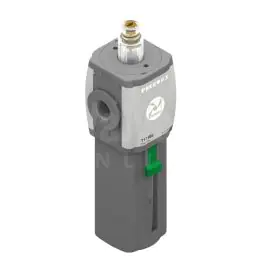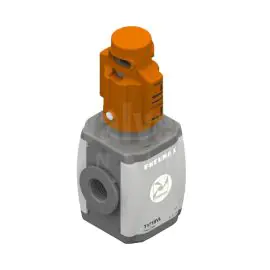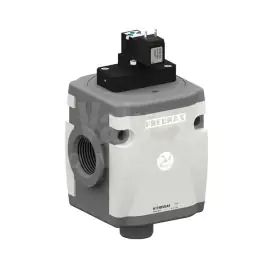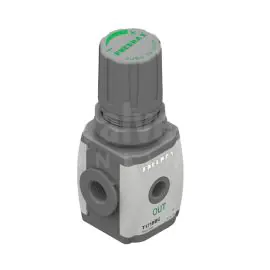Pneumatics for actuation and what you should know – Cleaning up your act…uator

Pneumatics for actuation and what you should know – Cleaning up your act…uator
Did you know, the major cause of pneumatic actuator failure is due to the ingress of moisture, oils and other contaminants entering the actuator via the air supply?
 |
This can be improved or even prevented by fitting a simple filter-regulator unit to the air supply that feeds the actuator assembly. For example, the centrifugal action of the filter helps separate large dirt particles, water and any compressor oil from the air before it passes through the filter element for its final clean. This will help prevent internal airways within the actuator becoming blocked as well as preventing debris causing damage to any of the actuator’s seals. In addition, the filter assembly is designed to remove any water which has condensed at that point, sending it to the bottom of the filter bowl and down to the drain assembly which can be either manually ejected or if the air supply never switches off automatically drained via an automatic drain assembly. |
Another fact that is generally overlooked is that a pneumatic actuator is sized on you being able to supply air at a pressure of between 5-7 bar, 75- 150 psi (unless requested differently when initially sizing the unit). Too much air could cause the seals inside the actuator to blow and too little may not be enough to move the actuator.The recommended pilot pressure should always be stated on the actuator label.
On filter/regulators, sometimes referred to as piggyback filter regs, a regulator is combined with the filter drain, allowing a precise and lockable flow of air into the actuator. An in-built gauge offers an indication of the pressure. This essential unit can be mounted onto the actuator, on the wall via a bracket or directly on the pipework

Finally, filtration is particularly important for positioners and I/P converters, modern designs incorporate piezo technology, which is reliant on clean, dry air; with manufacturers specifying 5-micron filtration.
Here at Valves Online we can offer specialised air preparation equipment from leading manufacturers at affordable prices. It’s important to remember, compressed air is expensive to generate and it’s good practice to only use what you need.
 |
 |
Pneumax AIRPLUS Filter - Regulator C/W Gauge
FROM £45.16 |
As upkeep, replacement and purchasing of equipment is so important Valves Online would like to introduce you to one of our industry-specific sister sites Pneumatic Select. Offering a range of Pneumatic Components including Mechanical Valves, Pneumatic & Solenoid Valves, Air Preparation Units, Cylinders, Fittings, and Accessories.
|
Combined Filter-Regulator-Lubricator systems, or FRL units, come equipped with pressure sensors, flow meters and other types of sensors for measuring air pressure, flow, contaminants and daily usage. This allows for the performance to be closely monitored, helping to identify faults and make adjustments before any problems occur. Analytics gathered can then be used to understand where improvements can be made and what, if anything is affecting performance.
As well as choosing the correct device, regular maintenance should be upheld to ensure that the equipment is running to spec, this will also help to extend the service life of your devices. Due to the importance of installing the correct FRL for your application, and to keep everything running with the minimum amount of maintenance possible, helping to keep costs low, we have come up with some key factors to consider.
EnvironmentSelecting the correct FRL for the operating environment, for example, whether it's indoors or out, will have a key factor on the materials and design used. You want to ensure that you pick a device suitable for extremes in varying temperatures and climates. |
 |
Outdoor units need to consider changes in temperature, from extreme hot to cold and will require components with specific temperature ratings. Extreme environments such as chemical or caustic operations, clean rooms, food and beverage preparation and ATEX conditions will demand different types of components, with secure seals or mountings inside a protective enclosure. For example, FRL used for marine environments must be able to withstand saltwater corrosion.
Pressure SpecificationThe specifications of your FRL depend on the air-supply pressure of the device, equipment or plant. Most FRL components are constructed to operate under pressures up to 10, in standard configurations and sizes, though some equipment air supplies are rated for up to 17 bar. In these circumstances, the equipment or device should specify a high-pressure regulator and filter unit – newer FRL models can even handle pressures up to 20 bar. LubricationNot all pneumatics require a lubricator, although it’s very common. Your machine will perform better with proper lubrication for its pneumatic valves and cylinders, which acts as a detergent in the air system and is built into the FRL assembly. The FRL continuously lubricates the system, with the clean oil washing out any contaminants that would cause sticking in the valves and cylinders. Non-lubricated pneumatics will usually need both coalescing and particulate filters instead, to remove the contaminants otherwise washed out by the lubricant.
|
 |
Lockout and Shutdown Valves
With today’s modular design architecture, it is simplicity itself to add lockout valves (high-flow exhaust) and/or shut-off or isolation valves (low-flow exhaust) to an FRL assembly. The decision to install such devices is application-specific and usually dictated by the machine's components. Manually or electrically activated lockout valves come in two versions – quick-exhaust or quick-exhaust with soft-start – which, when activated ensure that no airflow reaches components downstream of the FRL. They are commonly required in a pneumatic system to vent the air from the equipment in the event of a mechanical jam or an unsafe operator incursion.
Safety is paramount, so live pneumatic systems must always be shut off or isolated before any routine or emergency maintenance is performed. Isolation or shut-off valves are installed upstream of the FRL assembly, and are used to drain the potential compressed air energy safely into the atmosphere through a back-flow exhaust. Proper tag-out/lock-out procedures must also be observed.
Air Flow Rate
When selecting components for your FRL unit, the air flow rate is one of the most important factors to consider, as the FRL must be properly sized according to the machine's required flow rate. This rate is determined by calculating the volume of air required to fill and exhaust the relevant pneumatic component, and the amount of time required for the unit to respond. For most equipment designers, accurately calculating the air flow requirements of a pneumatic machine is one of their most complex and laborious tasks, but doing it correctly will make your pneumatic devices more efficient and cost-effective.
Engineers also match up the port size of the FRL with the port sizes of the cylinder or valve manifold, and many manufacturers supply FRLs in a series with overlapping port sizes. Significant increases in nominal flow rates can be achieved using each larger series, but changing port size also within a series can effect minimal alterations to flow capacity which may be more convenient.

Filter Replacement
One of the most important things to take into consideration is maintenance. Many users are not aware that pneumatic equipment's filter elements need to be replaced regularly or you can suffer poor performance from your equipment or even machine failure. Newer units will give ample warning signs when maintenance is required and older units can be monitored by checking the condition of filter and lubricator bowls for accumulated water and a steady oil supply.
FRLs may be the least prominent feature of a pneumatic system, but they have a significant impact on its efficiency and productivity. Correct selection, sizing and maintenance of FRL components will save money over time, as machines function more efficiently and for longer, experiencing fewer leaks and conserving both air and energy.










